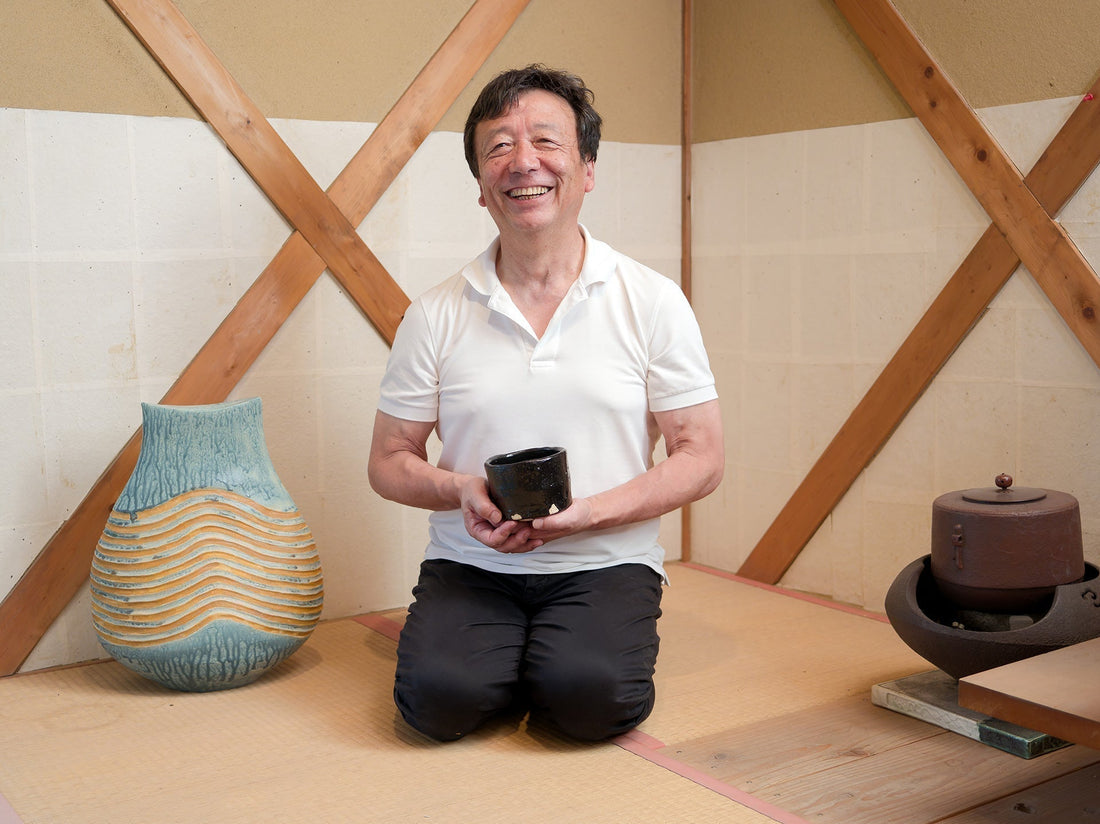
Interview with Ikuhiko Shibata of Hanzo Kiln
Sending messages from Mino to the world. Shibata Ikuhiko's pottery connects hearts and minds
Profile
(Ikuhiko Shibata)
- 1956
- Born in Tajimi City
- 1978
- Graduated from Meijo University
- 1987
- Hanzo Kiln Workshop opened
- 1995
- Joined the Mino Ceramic Art Association, a public interest incorporated foundation
- 1998
- Studied under Living National Treasure Kozo Kato
- 2003
- Ceramic wall production in Cincinnati, Ohio, USA
- 2006
- Held a solo exhibition in Cincinnati, Ohio, USA
- 2007
- Received the Excellence Award at the 13th Shorokusho Tea Bowl Exhibition
- 2013
- Lecture at the Cincinnati Art Museum, USA Cincinnati Pottery Lecturer at Funke Fired Arts in the same city (2013-2019)
- 2014
- Stayed in Boston, USA, making pottery and teaching pottery (continued thereafter)
- 2015
- Seven of his works are included in the collection of the Cincinnati Art Museum in the United States.
- 2017
- Pottery classes in Cincinnati and Boston
- 2019
- Teaching pottery in Cincinnati and Boston Solo exhibition at Takashimaya Osaka (5th time)
- 2020
- Solo exhibition at JR Nagoya Takashimaya
- 2023
- Lecture at the Cincinnati Art Museum, USA Solo exhibition at JR Nagoya Takashimaya Solo exhibition at Galleria Oribe, Tajimi City
- 2024
- Ceramic art classes and lectures in Cincinnati
- the current
- Held numerous solo exhibitions in Gifu, Nagoya, Tokyo, Osaka, etc. Director of the Mino Ceramic Art Association
Continuing to challenge myself to create something that never satisfies me
"Come in, please!"
Ceramic artist Ikuhiko Shibata came out to greet us with a smile, without an umbrella in the light rain.
At the back of the spacious parking lot, under a rain shelter, there is a dome-shaped anagama kiln surrounded by bricks, with firewood piled up.
An object is placed in front of the glass door of the workshop, which has an impressive triangular roof and skylight, creating a welcoming atmosphere. Continuing to the back of the workshop along the babbling brook Shibakusa River nearby, there are rows of relaxing chairs that look like they would be perfect for gazing out at the grassy backyard. Shibata-san said with a laugh, "I always take naps here." He said that he had recently done some DIY work to widen the eaves to create a more relaxing space. He then led us into the workshop through the back door.
Shibata's workshop, Hanzogama, is celebrating its 30th anniversary this year.
The wooden pillars, beams and ceiling have aged beautifully, staining an amber colour, and the spacious earthen floor with a comfortable atrium allows the breeze from the stream to pass through easily. Many of Shibata's works are displayed on the wooden floor, which is one step up, and at the back there is a tatami room for the tea ceremony and a wooden staircase. The glass entrance, walls and display shelves give a modern impression, accentuating the Japanese atmosphere of the space. There are also large speakers, and it seems that the owner has paid particular attention to acoustics.

A comfortable distance creates a warm bond
Looking around the studio, you'll see shelves lined with foreign books and works by foreign artists displayed on the walls of the gallery space. These were apparently gifts from overseas ceramic artists with whom he has connections. Shibata has been traveling to the US regularly for over 20 years, and has continued to interact and engage with local people through ceramics.
It all began in 2002, when they visited Cincinnati, Ohio, as part of a sister city exchange program with Gifu City, and created a ceramic wall column (a cylindrical pillar) to be installed in a park. The project took eight artists of different nationalities (China, Taiwan, Ukraine, Germany, France, Zimbabwe, the United States, and Japan) to complete the project over two months, staying with local families. They have cherished and expanded the connections they made there, and continue to interact and travel back and forth to this day.
Would he hesitate about a long stay in an unfamiliar foreign country or the language barrier when it comes to communication? Such doubts were quickly erased. "I'm absolutely not going to fail, I just need to consider this a success," Shibata says, and from his words and actions, there is not the slightest hint of anxiety or conflict about taking on a challenge. He always looks at things positively and is brimming with curiosity. "You're missing out if you don't have fun!" Shibata says, his eyes drooping and his big smile showing his friendly and open personality, which is sure to make him appealing to anyone, regardless of nationality. "As long as you have the same values, you can get along with people from any country," he says with a beaming smile.


We want to deliver a piece of pottery that satisfies the soul, without regard for profit or loss.
Shibata says of himself, "If there's one good thing I can say, it's to do something for others without thinking about profit or loss." During his time in the United States, he homestayed with close friends and gave pottery classes, lectures, and speeches, and he even volunteered to create 700 cups to raise donations, which he brought from Japan to the United States. His tireless efforts, as a way of "giving back to those who have shown kindness to him," surely help to create even more friendship.

This interview took place in the middle of the "Ikuhiko Shibata Ceramics Exhibition."
We also asked about the solo exhibition works that we saw at the gallery.
The exhibition guide features a bowl with a distinctive striped pattern of blue, a gradation from bright cobalt blue to indigo, and brown, a color close to yellow and orange. The name "Nishiki Oribe" is a combination of "Nishiki" (brocade), which comes from the blending of colors, and "Oribe" (oribe), which comes from Oribe ware , a style symbolized by free thinking.
Nishiki Oribe's works, which are said to be inspired by glazes, come in a variety of shapes, including large pitchers and flower vases, but when I picked up a small tea bowl, I was surprised at how light it was, contrary to the impression it gave from its appearance. This is apparently due to its thinness. There is also a double-sided base plate. The base has an intricate design with thick stripes and a circular pattern on the inside.
Shibata says he always wants to entertain those who see and use his work. However, he also says that the work he aims for is "not something original and eye-catching, but something ordinary and normal but interesting." Nishiki Oribe's works are Mino ware made with traditional techniques and materials, yet somehow give an impression of being both modern and retro, and it is clear that he has taken care to make them easy to use in modern everyday life.
Bowls, tea bowls, and sake cups, all named "Golden Shino," were small but made a strong presence at the venue. These gorgeous pieces feature gold decoration on a white Shino ware base. The gold accents include multiple diagonal lines and small, continuous protrusions reminiscent of polka dots, creating a luxurious and sophisticated atmosphere while also conveying a fresh impression. In ceramics, the gold is usually applied by firing at temperatures exceeding 700°C, but Shibata is particular about not firing the pieces. He instead uses the kintsugi technique, which uses lacquer, because "I don't see the point in firing," and this choice is also a way to preserve the luster without rusting.
Shibata said that the main focus of this solo exhibition is "Black Oribe ." It is not the new style "Nishiki Oribe" that is also used in the poster. While continuing to create traditional Mino pottery such as Shino, Kiseto, and Setoguro, Shibata said, "There was a time when I wanted to try something new, and now is the time I wanted to do it." He said, "The image has finally come together in my head." He says that he is inspired by everyday objects in his daily life, and often ponders, "What would I do on a potter's wheel?"
As an example, he cited a unique design piece with a motif of rock oysters and turban shells. It is a container with a lid that maintains stability with an exquisite balance. Shibata wondered if he could somehow incorporate the unique shape and texture of a shellfish he picked up at a sushi restaurant into a piece of art, and it took him two years to shape it on the potter's wheel and complete it. His high level of curiosity and sensitivity to information led to new ideas, and it seemed that his positive thinking and attitude led him to complete the piece.

It's like climbing a mountain...the scenery changes the more you climb, the more challenging it is.
Shibata has always had a smile on his face as he talked about his experiences and thoughts in an entertaining way, but when I asked him about his long career as a potter, he said something that really struck me: being a potter is like "climbing a mountain."
Shibata started making pottery in his late twenties and has been doing it for 40 years now. "It's best to just create your works little by little without getting too worked up," he says.
However, Shibata has plans to travel to the United States this fall, and has several solo exhibitions lined up for next year. He already has the design for his next piece in mind. He also plans to do a DIY renovation of the backyard space where his pottery materials are kept before the end of the year. The first floor will be used as storage space, and the second floor as a small room. He also has ambitious plans to build another building next door, a tea house. He also wants to improve the second floor of his studio, and improve his ink painting skills... Shibata's energetic activities as a potter will continue in the future, with his pride in wanting to deliver to users the "analog beauty" based on the delicate sensibilities unique to the Japanese, and the traditional Japanese culture that goes beyond convenience and is embodied in his pottery.

(June 2025, Interview: Chika Shimura)
information
Hanzo Kiln
6-70-1 Takirocho, Tajimi City, Gifu Prefecture, 507-0813




